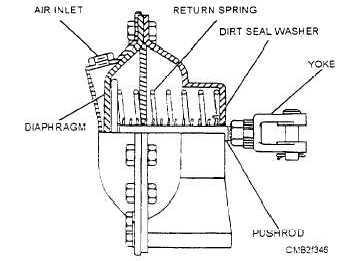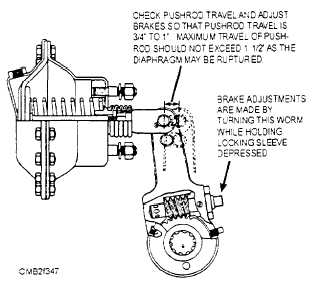any moisture buildup in the system. Moisture in the system prevents the brakes from actuating smoothly.
A safety, valve is located on top of the first reservoir and consists of an adjustable spring-loaded bail-check valve in a body. It is used to protect the system against excessive pressures. normally set at approximately 150 psi.
BRAKE CHAMBERS
The brake chamber (fig. 7-45) converts the energy of the compressed air into mechanical force to operate the brakes. When the brake pedal is actuated, air under pressure enters the brake chamber behind the diaphragm and forces the pushrod out against the return spring force. Because the yoke on the end of the pushrod is connected to the slack adjuster, this movement rotates the slack adjuster. brake camshaft, and cam to apply the brakes.
When the pedal is released, air is forced from the brake chamber by the brake shoe return spring acting on the linkage. After the shoes reach the fully released position, the return springs acting on the diaphragm causes it to return to its original position in the chamber.
When performing maintenance of the brake system, check the brake chamber alignment to avoid binding action. Check the pushrod travel periodically, and when necessary'. adjust the brakes so that pushrod travel is as short as possible without the brakes dragging. The pushrod length should be adjusted so that the angle between the center line of the slack adjuster and the brake chamber pushrod is 90 degrees when the pushrod is extended to the center of its working stroke.
Replace the diaphragm if it is worn or leaking. Replace the boot if it is worn or cracked. With the brakes applied, cover the edges of the diaphragm and bolt with soapy water to detect leakage. If leaks are present, tighten the bolts uniformly until the leaks stop. Bolts should not be tightened so that the diaphragm shows signs of bulging or distortion.
SLACK ADJUSTERS
The slack adjusters (fig. 7-46) function as adjustable levers and provide a means of adjusting the brakes to compensate for wear of linings. Air pressure, admitted to the brake chamber when the brake pedal is depressed, moves the slack adjuster toward the position indicated by the dotted lines.
The entire slack adjuster rotates as a lever with the brake camshaft, as the brakes are applied or released. Turning the adjusting screw makes the brake adjustments necessary to maintain proper slack adjuster arm travel (shoe and drum clearance). This action rotates the worm gear, camshaft, and cam. expanding the brake shoes so that the slack caused by brake lining wear is eliminated and the slack adjuster arm travel is returned to the correct setting. The movement of the cam forces the brake shoes against the brake drum. Friction of the brake lining against the drum stops the turning movement of the wheel. When the brakes are released, the brake shoe return spring pulls the shoes back to a DISENGAGED position.
BRAKE VALVES
There are numerous brake valves used in an air brake system. These valves either apply or release air

Figure 7-45. - Brake chamber.

Figure 7-46. - Slack adjuster.
Continue Reading